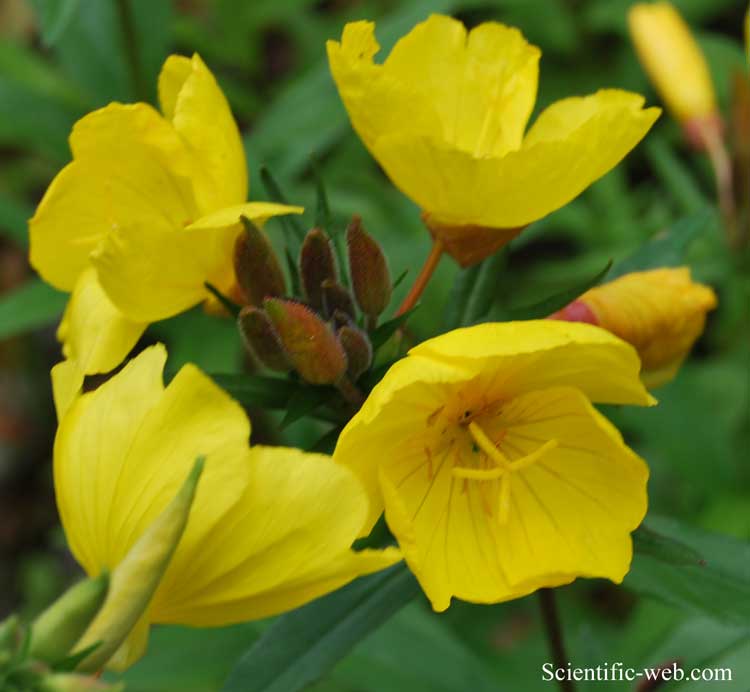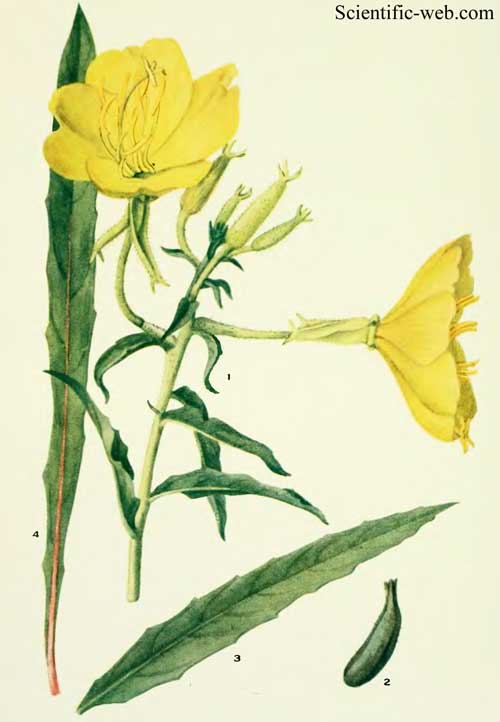
Oenothera argillicola, Photo: Michael Lahanas
Cladus: Eukaryota
Regnum: Plantae
Divisio: Magnoliophyta
Classis: Magnoliopsida
Ordo: Myrtales
Familia: Onagraceae
Subfamilia: Onagroideae
Tribus: Onagreae
Genus: Oenothera
Species Oenothera argillicola
Name
Oenothera argillicola Mack.

Oenothera argillicola
References
* Torreya; a Monthly Journal of Botanical Notes and News 4:56. 1904
* USDA, ARS, National Genetic Resources Program. Germplasm Resources Information Network - (GRIN) [Online Database]. [1]
----------
Oenothera is a genus of about 125 species of annual, biennial and perennial herbaceous flowering plants, native to North and South America. It is the type genus of the family Onagraceae. Common names include evening-primrose, suncups, and sundrops.
The species vary in size from small alpine plants 10 cm tall (e.g. O. acaulis from Chile), to vigorous lowland species growing to 3 m (e.g. O. stubbei from Mexico). The leaves form a basal rosette at ground level and spiral up to the flowering stems; the leaves are dentate or deeply lobed (pinnatifid). The flowers open in the evening, hence the name "evening-primrose", and are yellow in most species but white, purple, pink or red in a few. Most native California species are white. The fragrant evening-primrose Oenothera caespitosa, a California species, first blooms white but turns pink or light magenta.[1]
One of the most distinctive features of the flower is the stigma with four branches, forming an X shape.[2] Pollination is by Lepidoptera (moths) and bees; like many members of the Onagraceae, however, the pollen grains are loosely held together by viscin threads (see photo below), meaning that only bees that are morphologically specialized to gather this pollen can effectively pollinate the flowers (it cannot be held effectively in a typical bee scopa). Furthermore, the flowers are open at a time when most bee species are inactive, so the bees which visit Oenothera are also compelled to be vespertine temporal specialists. The seeds ripen from late summer to fall.
Oenothera species are used as food plants by the larvae of some Lepidoptera species including Schinia felicitata and Schinia florida, both of which feed exclusively on the genus, the former exclusively on O. deltoides.
In the wild, evening-primrose acts as a primary colonizer, quickly appearing wherever a patch of bare, undisturbed ground may be found. This means that it tends to be found in poorer environments such as dunes, roadsides, railway embankments and wasteland. It often occurs as a casual, eventually being out-competed by other species.
The genus Oenothera may have originated in Mexico and Central America [3][4] from which it spread into North and South America and, with the advent of international travel, species are now found in most temperate regions. During the Pleistocene era a succession of ice ages swept down across North America, with intervening warm periods. This was repeated for four ice ages, with four separate waves of colonization, each hybridizing with the remnants of the previous waves [4][5] This generated a present-day group of species forming the subsection Euoenothera which is very rich in genetic diversity, spread right across the North American continent. These species are morphologically diverse and are largely interfertile and so the species boundaries have been a source of dispute amongst taxonomists.[3][6]
This pattern of repeated colonizations resulted in a unique genetic conformation in the Euoenotherae whereby the chromosomes at meiosis can form into circles of varying size, rather than complete chromosome pairing as in common meiosis. This is the result of several reciprocal translocations between chromosomes so that the pairing occurs only at the tips. This phenomenon has some apparently non-Mendelian genetic consequences. By combining this mode of chromosome segregation with a system of balanced-lethal genes, genetic recombination is prevented and the plants enjoy the vigour of heterosis.[7] This resulted in the evolution of a large number of sympatric races over North America, east of the Rocky Mountains. Analysis of the cytology of these races and of artificial hybrids between them allowed a detailed understanding of the genetic and geographic evolution of the Euoenotherae. This whole subject was a major area of genetic research during the first half of the 20th century.[5][8]
Evening-primrose was originally assigned to the genus Onagra, which gave the family Onagraceae its name. Onagra (meaning "(food of) onager") was first used in botany in 1587, and in English in Philip Miller's 1754 Gardeners Dictionary: Abridged. Its modern name Oenothera was published by Carolus Linnaeus in his Systema Naturae. William Baird [disambiguation needed] suggests that since oeno means "wine" in Greek it refers to the fact that the root of the edible Oenothera biennis was used as a wine flavor additive.
In 1905, while studying the genetics of Oenothera lamarckiana, Hugo de Vries discovered a variant with a chromosome number of 2N = 28 compared with 2n = 14 for O. lamarckiana. DeVries was unable to breed this variant with O. lamarckiana. He named the variant Oenothera gigas.[9]
Cultivation and uses
Young roots can be eaten like a vegetable (with a peppery flavor), or the shoots can be eaten as a salad. The whole plant was used to prepare an infusion with astringent and sedative properties. It was considered to be effective in healing asthmatic coughs, gastro-intestinal disorders, whooping cough and as a sedative pain-killer. Poultices containing O. biennis were at one time used to ease bruises and speed wound healing. One of the common names for Oenothera, "Kings cureall", reflects the wide range of healing powers ascribed to this plant, although it should be noted that its efficacy for these purposes has not been demonstrated in clinical trials.
The mature seeds contain approximately 7-10% gamma-linolenic acid, a rare essential fatty acid. The oil also contains around 70% linoleic acid[10]. The O. biennis seed oil is used to reduce the pains of premenstrual stress syndrome. Gamma-linolenic acid also shows promise against breast cancer.[11]
Evening-primroses are very popular ornamental plants in gardens. For propagation, the seeds can be sown in situ from late spring to early summer. The plant will grow successfully in fertile soils if competing species are kept at bay. Evening-primrose species can be planted in any ordinary, dry, well-drained garden soil (preferably sandy loam) in an open site that is sunny to partly shady. They are fairly drought-resistant.
The first plants to arrive in Europe reached Padua from Virginia in 1614 and were described by the English botanist John Goodyer in 1621. Some species are now also naturalized in parts of Europe and Asia, and can be grown as far north as 65° N in Finland. The UK National Council for the Conservation of Plants and Gardens, based at Wisley, maintains an Oenothera collection as part of its National Collections scheme.
References
1. ^ Calflora database
2. ^ Roger Tory Peterson and Margaret McKenny (1968). A field guide to wildflowers of northeastern and north-central North America. Boston: Houghton Mifflin. ISBN 0-395-91172-9.
3. ^ a b Peter H. Raven; Werner Dietrich, Wilfried Stubbe (1979). "An outline of the systematics of Oenothera subsect. Euoenothera (Onagraceae)". Systematic Botany 4 (3): 242–252. doi:10.2307/2418422.
4. ^ a b Werner Dietrich; Warren L. Wagner, Peter H. Raven (1997). Systematics of Oenothera section Oenothera subsection Oenothera (Onagraceae). Laramie: The American Society of Plant Taxonomists. ISBN 0-912861-50-9.
5. ^ a b Ralph E. Cleland (1972). Oenothera - Cytogenetics and evolution. Boston: Academic Press. ISBN 0-12-176450-8.
6. ^ Krzysztof Rostanski (1985). "The classification of subsection Oenothera (section Oenothera, Oenothera L., Onagraceae)". Feddes Report 96 (1-2): 3–14.
7. ^ Uwe Rauwolf; Hieronim Golczyk, Jörg Meurer, Reinhold G. Herrmann, Stephan Greiner (2008). "Molecular marker systems for Oenothera genetics". Genetics 180 (3): 1289–1306. doi:10.1534/genetics.108.091249. PMID 18791241.
8. ^ Cornelia Harte (1994). Oenothera - Contributions of a plant to biology. Berlin: Springer-Verlag. ISBN 3-540-53114-9.
9. ^ "Observed Instances of Speciation". Joseph Boxhorn. 1995-09-01. http://www.talkorigins.org/faqs/faq-speciation.html.
10. ^ National Non-Food Crops Centre."Evening Primrose", Retrieved on 2009-03-27
11. ^ "Plant oil 'acts like cancer drug'". BBC News. 2005-11-02. http://news.bbc.co.uk/2/hi/health/4395826.stm. (describing work by Dr Javier Menendez and colleagues at Northwestern University and published in Journal of the National Cancer Institute).
Retrieved from "http://en.wikipedia.org/"
All text is available under the terms of the GNU Free Documentation License

